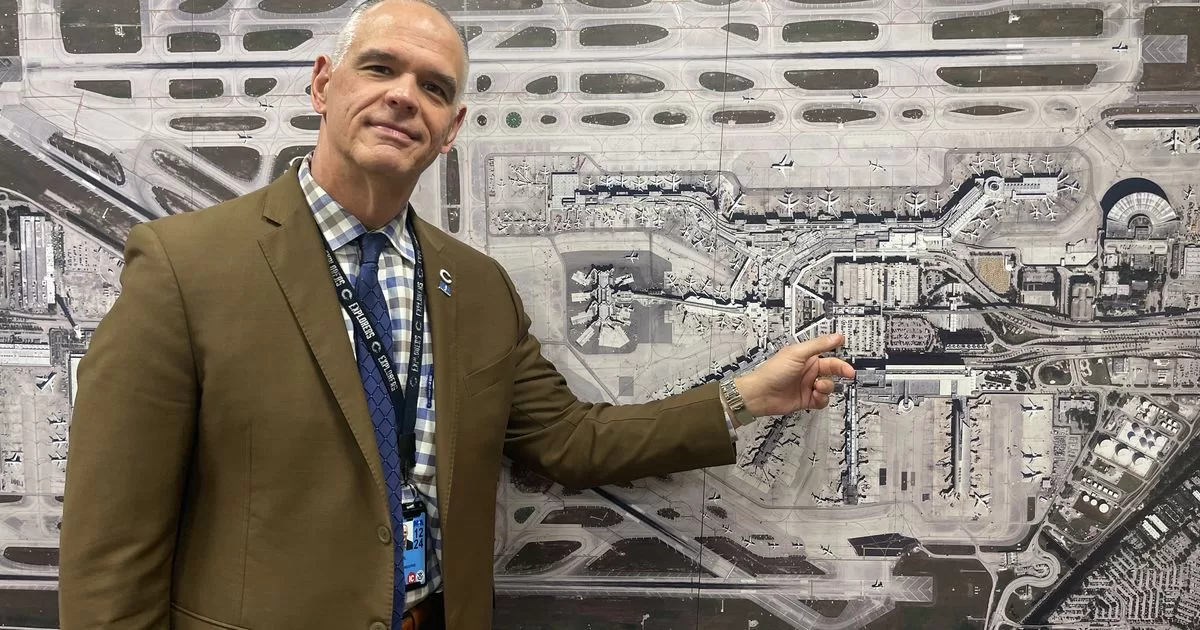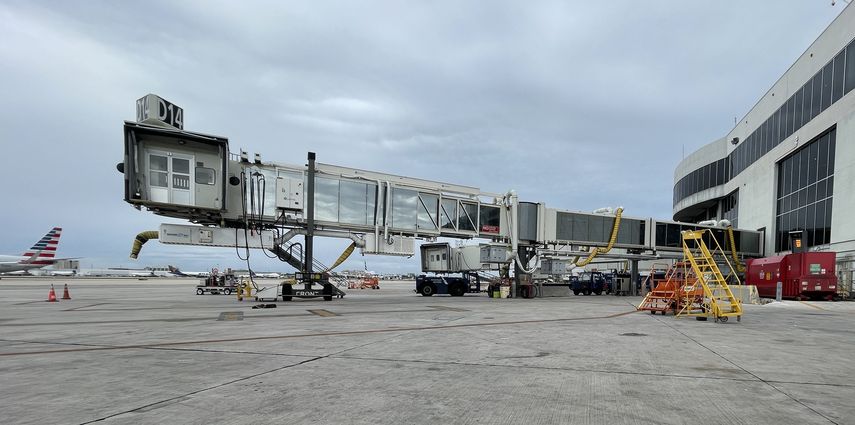Some members of the public and media wondered how it was possible that the main economic engine of South Florida, whose impact is almost 32,000 million of dollars and generates between direct and indirect jobs 300,000 jobscould have been “neglected.”
And as if that were not enough, some posts from MIA users dissatisfied with the conditions of their facilities began to appear on social networks. They showed old and dirty bathrooms, escalators and elevators out of service, leaks in ceilings in some areas, useless mechanical mats and to top it off, the Skytrain service was interrupted.
In order to fully understand what is happening at Florida’s main air terminal, DIARIO LAS AMÉRICAS spoke with Ralph Cutie, its current director, who since 2013 has held relevant positions at MIA.
Cutie believes that the previous directors They had other priorities that allowed them to break current traveler records for two consecutive years.
Miami-Dade Commission
The reality is that, in 2019, when Carlos Giménez was mayor, the Miami-Dade Commission approved a budget of 5.6 billion dollars to invest in MIA. “That fund was for the airport’s capital improvement program, that is, expanding the terminals and modernizing them,” clarified the director, who explained that during COVID work was suspended because it was not known how the industry was going to recover after COVID. the pandemic. “There were experts who argued that it would take seven years to recover the global aeronautical industry.”
When the pandemic ended, “we had to update the approved budget.” In 2023, the Commission took up the budget and approved it for 7,000 million“to validate all the estimates since the price of construction and labor had risen more than 50%.”
Perfect storm
The image that Cutie finds to explain what happened at MIA is the perfect storm. At the time of undertaking the renovations, COVID emerged which slowed down investments and improvements. After the pandemic, every year we have broken passenger records. Renovations and expansions occur in 8.5 million square feet of air-conditioned space, where 200,000 people interact each day and 1,000 flights are operatedCutie indicated to understand the complexity of the issue.
Elevators and escalators
The airport has 616 mechanical units, between elevators, mats and escalators. Currently, these units are served by four contracts. Schindler Elevators has 380 units in one contract and 133 in another; Thyssen, 64; and OTIS, 39 units. But this was not always so.
In the last eight years there was a large turnover of contracting companies in charge of the airport’s mechanical units. Something that goes against its proper maintenance.
In 2017, Kone Elevator, which was the company that owned the contract for the 380 units, stopped providing service. Easter Elevator held the contract for almost a year until Oracle began maintenance work after winning a bid. “At first they worked very well, but later security problems were detected and the mayor, based on reports of violations, decided to terminate their contract,” the director recalled.
When Schindler won the contract for the 380 units in 2022, it conducted a thorough inspection of each one to determine what problems they had. They are units that are between 30 and 40 years old and their useful life is 20.
It should be noted that the parts must be ordered and manufactured especially for each unit, he said.
The contract with Schindler is for $581 million, for 10 years, with the right to five more, if the County requests it. It stipulates the replacement of 140 units, maintenance and major repairs on the rest during the duration of the agreement. Each year between 30 and 45 units must be renewed.
Cutie pointed out that he is satisfied with the work that Schindler is developing, highlighting that the company increased the staff of technicians, created different work shifts, including night and weekend shifts. “Until now they did not exist. On weekends there was a technician on duty at his house “on call” who would take two hours to get here in the event of any breakdown.
Currently, of the 616 units at the airport, 50 are out of service, that is, 8%. The idea is to work to reduce the percentage to 2%. “It will never be zero due to the wear and tear we have here at the airport.”
old bathrooms
“A new, modern bathroom that has just been built can be dirty and the public does not notice it. However, an old bathroom, even if it is clean, people see as horrible,” said Cutie when showing the new services.
In the terminal we have 447 bathrooms. The renovation program began before I became director. Currently we have finished renovating 40 services, 9 are under construction, 18 under permit and 141 are being designed.
“We have an office of the County Building Department at the airport itself, where we apply for construction permits. Despite that, permits can take a month.”
Right now, we have three companies designing bathroom designs. Each one carries a little more than 30 services. As these designs are approved, we put packages of twelve bathrooms out to tender so that they can be built and thus save time.
The traveler’s map
Concerned about the operation and image of MIA, the director maintained that he had created “the traveler’s map.” A document that lists in order the different points that a passenger travels from when they get off the plane until they go out onto the street: the passenger passes through the boarding bridge, the bathrooms, the elevators, the mechanical mats.
“The first thing is boarding bridgesthe structure where they get off the plane. In MIA there are 128 boarding bridges. Many of these structures are between 30 and 40 years old. We have already started replacing them, so far we have installed 34 new ones. Another 10 will soon be put out to tender.
We want all those that are built to be made of glass so that, in addition to improving the traveler’s experience, glass is a material that is more resistant to our climatic conditions and contains fewer metal pieces that are prone to rust.”
These boarding bridges are custom manufactured, have electromechanical components, hydraulic lifting, telescopic extension system, air conditioning and are operated by specialized personnel.
In addition to the bridges, “we are prioritizing the renovation of the bathrooms that are near the passenger exits.”
Skytrain resumes in March
Skytrain service, which carries more than 40,000 travelers daily over 0.7 miles within MIA, was interrupted for safety reasons. The reason was that “during a routine inspection in September, our engineers discovered that there were cracks in 5 of the 130 pillars of the elevated structures where the train runs.”
Repair work has already begun. Stations #2 and 4 will resume service at the end of March. And the full Skytrain line will be operational by the end of July. The value of the work is 4.2 million dollars.
“The most appropriate decision was to interrupt the circulation of the Skytrain. We wanted to avoid having a situation similar to the Surfside collapse or the fall of the FIU bridge,” the manager said.
More Works
“On the 20th we will begin the construction of a new employee parking lot that will add 2,250 new spaces and will free up space in passenger garages.”
A $750 million tender begins this month for the expansion of the South Terminal. It will take approximately a year and a half to study the different proposals and determine the contractors. The new terminal, which will have six boarding gates, will be completed in 2029.
The Central Terminal, which is more than 70 years old, will also be renovated. “Now in February, we are going to start a tender for the modernization of the first phase of the Central Terminal where we will invest 380 million. Then we will renew the second phase for the same amount. The Central Terminal arrangements will be completed in 2030, Cutie said.
All the work we are doing is necessary to be able to receive the number of passengers indicated by the projections. In 2022 we received 50.7 million, in 2023, 52.3 million traveled, and to date, we are exceeding the passengers received last year by 11%. The projection is to reach 77 million travelers in 2040.
“It is important for the public to know that we are actively working not only to modernize and maintain the airport, but also with an eye to the future,” he concluded.
(email protected)
@menendezpryce






